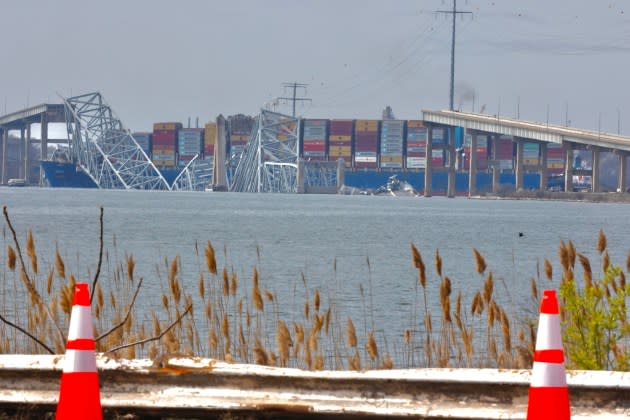Francis Scott Key Bridge Expected to Rebuilt by Fall 2028

Maryland transportation officials said Thursday that they expect to replace Baltimore’s Francis Scott Key Bridge with a new span by fall 2028.
The project to replace the bridge, which collapsed into the Patapsco River early March 26 after the Dali cargo ship crashed into one of its support columns, is estimated to cost between $1.7 and $1.9 billion, Maryland Transportation Secretary Paul Wiedefeld said.
More from Sourcing Journal
The Port of Baltimore plans to handle the return of cargo at the end of May after being forced to shutter its operations when much of the 1.6-mile bridge collapsed. In the time since the incident, Unified Command response and recovery team has been cleaning the wreckage of the bridge, and opened up multiple shipping channels so vessels idling in the harbor could finally exit on their route.
The main 50-foot-deep channel is still expected to open around the end of May.
“Reopening this port and rebuilding this bridge as quickly as possible is in the interest of every American,” said Congressman Steny Hoyer in a statement. “I praise the Unified Command for its continued dedication during this difficult hour. As I saw during my visit to the wreckage, emergency personnel are working around the clock to get the Port of Baltimore back up and running. It’s crucial that the federal government provide them with vital resources for this project immediately. This is not an act of charity; it’s an investment in the American economy.”
For the past six weeks, container shipping companies have rerouted away from Baltimore to instead drop off goods at alternate ports including New York & New Jersey, Norfolk, Va. and Philadelphia, where the goods are being transported to the Baltimore area via truck.
“In the grand scale of things, this is not tremendously severe,” said Timothy Stone, vice president of supply chain risk management at Exiger, of the lingering supply chain impacts potentially caused by the collapse. “If anything, like the Red Sea crisis, this has shown that our supply chains are more adaptable and resilient, and since Covid, they’ve gotten better at adjusting to these jolts.”
Ocean carriers have told the port’s management they have begun accepting bookings for shipments to the port, according to Jonathan Daniels, CEO of the Maryland Port Authority.
The Maryland Transportation Authority, which oversees the bridge, will be holding a virtual forum May 7 with the construction industry as the agency develops a formal request for proposals.
As of April 30, 41 percent of shipments originally destined for Baltimore were rerouted primarily to New York, while another 30 percent went to Norfolk, according to data from supply chain visibility platform Project44. Ten percent have instead been transported to Newark-Elizabeth.
Overall port dwell has not increased at these ports, but dwell of rerouted containers is trending up to 85 percent higher than overall dwell, Project44 says.
If there’s one area shippers may still have to worry about going ahead of, it’s the potential fines for keeping cargo at the new ports.
Project44 estimates that the demurrage charges on the containers being rerouted totals $3.9 million weekly. Last month, the Federal Maritime Commission (FMC) warned carriers that these fees would have to be “reasonable.”
The demurrage charges come on top of the added costs shippers must worry about in the wake of the container shipping giants invoking force majeure. This clause frees the carriers from fulfilling contract obligations due to events out of their control, and makes shippers fully responsible for finding transportation to move the cargo to its final destination before container late fees are charged.
Scott says the continued investment in more vessels has enabled more container shipping companies to bounce back from disruptions like those in Baltimore quicker, with Mediterranean Shipping Company (MSC) and CMA CGM alone accounting for 198 new ships in their orderbook, according to data from Alphaliner.
“We’ve built up more capacity. With the container lines and the tankers making tremendous amounts of money during that period of time when the rates were so high, they were able to invest in more capacity which has been coming online which has helped which has helped absorb these disruptions,” Scott told Sourcing Journal in April. “Just anyone now as a professional and who lived through the pandemic, is much more accustomed to a bigger shock, because it was such a shock to the system that this kind of pales in comparison.”
Solve the daily Crossword

